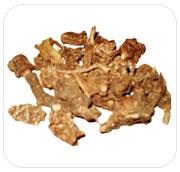|
Indian Sarsaparilla - Hemidesmus indicus - Magarbu or Anantmul
|
Indian Sarsaparilla

|
|
|
|
Indian Sarsaparilla - Hemidesmus indicus - Magarbu or Anantmul
Botanical Name: Hemidesmus indicus
Indian Name: Magarbu or Anantmul
Sanskrit: Anantamul
Hindi: Kapuri
Tamil Name : Nannari
English: Indian Sarsaparilla
Telugu: Sugandhi-pala
Common names: Sariva, sarbia, ontomulo, naruninti Nannari, tygade beru, anant-vel, durivel
Family name: Asclepiadaceae
Health and Benefits Of Indian Sarsaparilla
- Indian sarsaparilla is useful for treating stomach disorders like dyspepsia and loss of appetite.
- The roots ground a paste with water and mixed with pepper is useful in stomach ache and diarrhea.
- Indian sarsaparilla contains a hair growing hormone. A decoction of the root is used as a hair wash to promote hair growth.
- The herb is beneficial in leucorrhea, syphilis and other genitor urinary diseases. A decoction of its roots is to be administered in 60 to 90 ml doses thrice a day. Syrup made from its roots is an effective diuretic.
- A paste of its roots is applied locally in treating swelling, rheumatic joints and boils.
- The drug is effective is the treatment of fevers. Its diaphoretic properties, that is, sweat inducing properties; induce copious perspiration, thereby reducing the temperature.
- Good remedy for gout , epilepsy, insanity, chronic nervous diseases.
- It also effects nervous system. It cures intestinal gas, debility, impotence, turbid.
- It is a good blood-cleanser.
- Indian Sarsaparilla stimulates the production of sexual hormones. The root extract has antibacterial activity.
- In Ayurveda it goes by the name of ananthamoola or Anantmula. It is also called the False Sarsaparilla. The plant enjoys a status as tonic, alterative, demulcent, diaphoretic, diuretic and blood purifier. It is employed in nutritional disorders, syphilis, chronic rheumatism, gravel and other urinary diseases and skin affections.
Indian sarsaparilla is a perennial twining or creeping herb with greenish flowers in small compact clusters and narrow cylindrical fruits. It has a woody fragrant rootstock, slender hairless stem and variable dark green leaves. The dried roots constitute the drug.
On simple distillation with water, the roots yield a steroptency which is supposed to be a volatile acid. It also contains an essential oil. The odour of the drug is due to couumarin. The roots also contain resins, tannin and glycoside.
|
| |
|
Botanical Name: Hemidesmus indicus
Indian Name: Magarbu or Anantmul
Sanskrit: Anantamul
Hindi: Kapuri
Tamil Name : Nannari
English: Indian Sarsaparilla
Telugu: Sugandhi-pala
Common names: Sariva, sarbia, ontomulo, naruninti Nannari, tygade beru, anant-vel, durivel
Family name: Asclepiadaceae
|
|